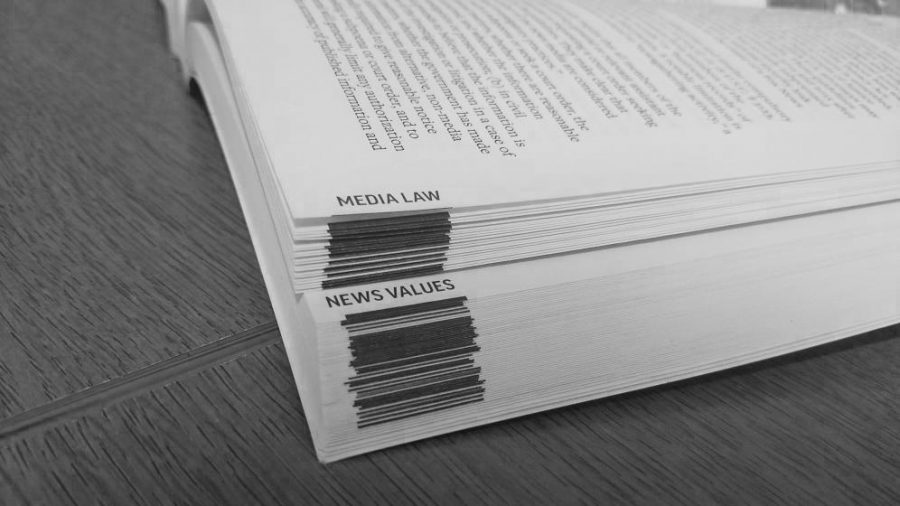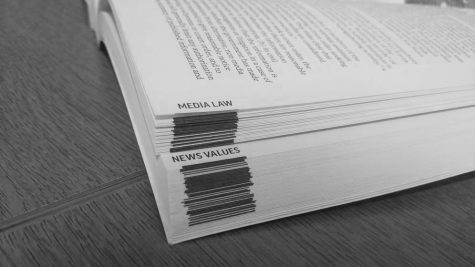Know Your Rights, Know Good Journalism
A Crash Course in Media Law and Media Ethics
A peek into the AP Stylebook, featuring the sections on Media Law and News Values.
With the ever-increasing impact of the internet, information is spreading faster and easier every day. This is especially true with the ongoing pandemic situation, where information changes by-the-minute. However, to quote the great Stan Lee, “with great power, comes great responsibility.” In the case of sharing news, that responsibility falls under following the guidelines shared with journalists from both the government and the Associated Press (AP). Not only does the AP Stylebook outline proper spelling and usage of terms, it has an expansive section explaining media law and media ethics and remains “an essential tool in newsrooms, classrooms, and boardrooms alike” (as stated in the book’s foreword).
The AP Stylebook is a comprehensive reference manual published and updated by the Associated Press every year. The foreword describes how the first edition that came out was a mere 60 pages that were bound together with staples, compared the latest 2019-version that is over 600 pages. Over 200 entries have been added since last year. For example, some common terms or entries that you may see:
August 26, 2019 -> Aug. 26, 2019
August 26 ->Aug. 26
August 2019 -> August 2019
Infant: acceptable for all children through 12 months old.
The word president is not to be capitalized in a sentence unless it is behind a name, such as President Donald Trump. However, where you have to use his full name the first time you reference him, you only use President Trump any time after. In reference to former presidents, you would do the same but the word “former” is never capitalized and always included, such as former President Barack Obama.
You would capitalize words such as Communist when referring to the specific party, but not when it is used as a noun or adjective, such as communism.
Couture refers to the design and manufacture of fashionable clothing, usually custom made.
For many people outside of the world of journalism, the concept of “media law” may sound absurd. The first amendment protects the freedom of the press, right? Correct, but during the Vietnam war, there were many legal changes governing the press. According to the AP Stylebook, it applied “the First Amendment’s protection of speech and press with new force and meaning.” These changes paved the way for quality journalism as we know it.
The AP Stylebook covers two overarching themes, newsgathering and news content. Here’s the big points to help you know good, ethical journalism when you see it.
- If a reporter promises confidentiality or anonymity and later reveals the name or identity of their source, they can be held liable for breaching it.
- This can include promises of anonymity in photos or as a source of information
- Journalists cannot invade someone’s private life without permission
- This includes entering their physical space, such as their home or business, and their personal matters, such as private financial statements or personal emails.
- This doesn’t include standing on public fixtures, like sidewalks, and hearing or seeing things. That space is fair game to the public.
- When entering your space, a reporter should identify themselves and show some kind of credential to ensure you that they’re where they say they are from.
- Consent to enter private space from minors and other people legally incapable of giving consent will not count as consent in court.
- Defamation is two different sides of misreporting: libel and slander
- In Ohio, libel is defined as anything written or published false statement presented as fact that damages a person’s reputation.
- Slander is anything spoken and presented as fact that damages a person’s reputation.
The exact wording for the definition of defamation from a 2004 Ohio court case is: “A false statement that: causes injury to a person’s reputation; exposes him to public hatred, contempt, ridicule, shame, or disgrace; or affects him adversely in his trade or business.”
Why does it matter to know when and where journalists can collect information from you? As with any right, you never know when you might need to assert it. This is also good information to know as someone who reads journalism. If you’re reading from someone following these laws, you can trust that your journalist is more likely to give you complete and accurate information from the correct sources.
Some practices outlined in the AP Stylebook aren’t necessarily law, but ethical values that any good and credible journalist should follow. Here’s some important points that everyone should know.
- Attribute all sources when possible
- This one has a lot of grey area, since some sources may request anonymity to preserve their position within a situation, like a job. If the situation calls for it, their position of credibility is described instead, for example “a manager for the company said. . .”, otherwise their full name and title should be used.
- Avoid situations that may create a conflict of interest
- Good journalists can still be active with religion, charity or other organization, but they must be mindful of ensuring they hold little to no bias or personal stake in a story.
- Avoid spreading hate and propaganda
- The AP Stylebook says “When hate speech or images are the basis of a news story, it is often sufficient to briefly refer to the speech or images in a text story rather than carry the speech or propaganda at length or redistribute the images.”
- In the same section, they state that a good journalist avoids using obscenities or slurs, as well as avoiding using imagery with slurs or obscenities. If a story can’t be told without using them, they should be flagged at the top with a warning so readers will be prepared.
- Avoid identifying victims or minors
- The AP Stylebook specifically mentions avoiding mentioning victims of assault or abuse unless they identify themselves publicly first.
- They also specify that good journalists don’t mention the names of minors who were accused of a crime or witness to a crime.
- This point specifically relies heavily on context, such as if a minor or juvenile is convicted as an adult or the subject of a manhunt, or if an assault victim identifies themselves publicly beforehand.
- Absolutely no fabrications
- The AP Stylebook is very firm on producing or recreating any material.
- “Nothing in our news report – words, photos, graphics, sound or video – may be fabricated . . . We don’t stage or re-enact events for the camera or microphone.”
- This one is hard to spot, unless you’re diligent about fact checking. Typically this comes with trust in your news source and looking into the criteria explained in the previous points should lead to this point becoming a no-brainer.
Media literacy is imperative, since the spread of information—and misinformation— is occurring faster than ever. With these points in mind, you’re set to trust that what you read is accurate and unbiased, as well as know if someone is the subject of a breach in media law.

Anissa Peoples is a fifth-year senior studying English-Communication with a minor in fine arts game design. A seasoned writer, she has written for the...



